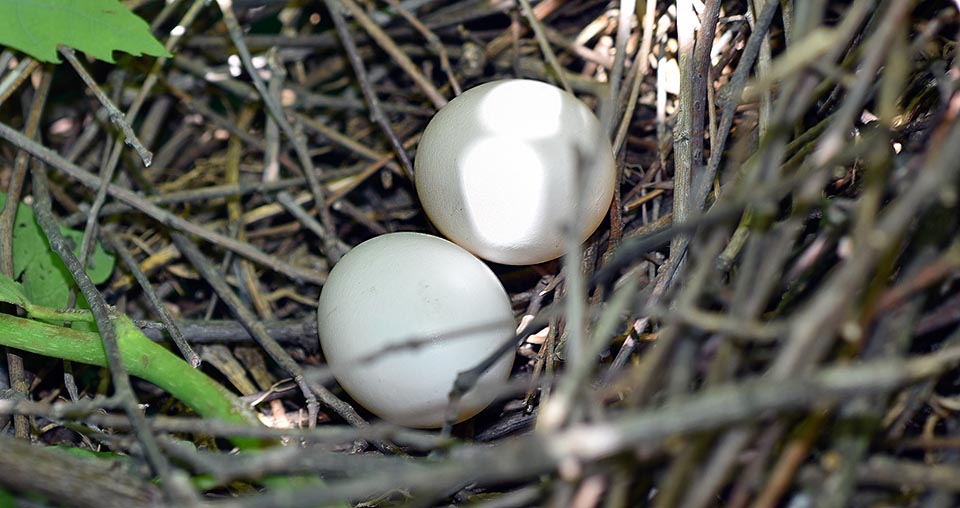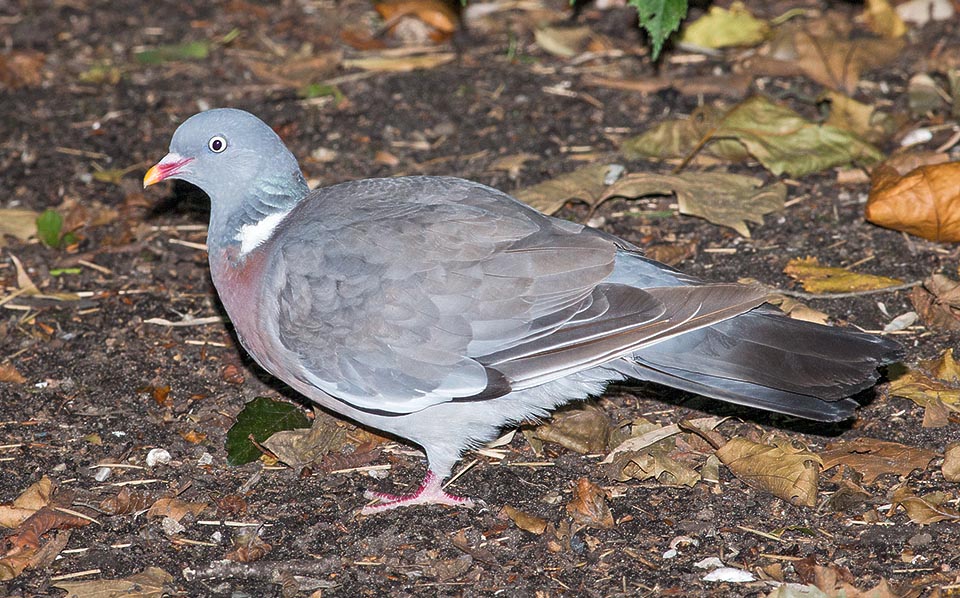Family : Columbidae

Text © Dr. Gianfranco Colombo

English translation by Mario Beltramini

Definitely expanding species, the wood pigeon (Columba palumbus ) occupies a very vast territory covering totally Europe up to Urals and then, even more, through Middle East, has colonized almost all the temperate belt of Asia, up to the vast Indian plains. Six subspecies have been classified © Gianfranco Colombo

Here it is in the wild enticed and cautious on an elder full of fruits © Giuseppe Mazza
It was then unthinkable to meet it right in town surrounded by the city hustle and bustle.
It was a wild bird, wary, careful, circumspect and difficult to approach, characteristics that are still now present in the country specimens or in the populations living far away from the anthropized sites.
It was however enough to go in any London park to see it walking between your feet in great number, cooing loudly over the lowest branch two palms from the head of a gentleman sitting on the bench when not even while brooding at the entrance to the park indifferent to human presence.
An urban bird, nowadays accustomed to city life.
Conversely, the real character of this bird is well known to the hunters who hunt it actively seen the great number and the goodness of its flesh.
A wary prey, very intelligent in dodging the tricks and the decoys placed for attracting them.
Even, due to its invasive character, in some nations like the United Kingdom, the hunting season for this bird lasts practically the whole year rightly because it is considered as dangerous to the agriculture.
Conversely, in South Europe where converge the enormous migrating populations coming from the north continental areas, the hunting activity is done only in autumn with great expectation and passion by a considerable number of hunters.
The Common wood pigeon (Columba palumbus Linnaeus, 1758) belongs to the order of the Columbiformes and to the family of the Columbidae and is the biggest and the most diffused among all European pigeons.

They are ripe and irresistible. Since always its choice fruits, together with the ivy's ones, the acorns and the salads of beeches inflorescences © Giuseppe Mazza

But now the wood pigeon has anthropized and when in the sky flies such a flock the farmers are rightly worried for the harvest © Gianfranco Colombo
As often occurs, the genesis of the scientific names gets lost disorderly over time, originating various and confused interpretations.

Here it is in a corn field, but damages also grain, rice, soy and sunflower cultivations, and may destroy an orchard, breaking in group, with the weight, the trees branches © Gianfranco Colombo

Then, as if nothing happened, the vandal flees. Almost double than the common rock pigeon, the Comlumba palumbus can be 40 cm long, with 75 cm of wingspan and even 600 g © G. Colombo
Just to render the interpretation even more chaotic, we have finally to remind that with the Icelandic term klumba they indicate the Guillemots (Cepphus grille) rightly due to the similar size and to the fact that also them lay two eggs as typical to the Columbidae.
By sure the historical prevalence on this northern language, stands in favour of the Latin but it would be interesting to know its origins and the matchings or perhaps the linguistic copying and misspellings occurred during the centuries.
The name of the species palumbus also comes from the Latin, but simply from “palumbes” = wild pigeon, because of the prevailing habitat of this bird.
This bird is called Wood Pigeon in English, Pigeon ramier in French, Ringeltaube in German, Colombaccio or Palombo in Italian, Paloma torcaz in Spanish and Pombo-torcaz in Portuguese.
To notice the weirdness in the Iberian languages where the name torcaz comes from the Latin torques = band, collar, rightly due to the drawing it has on the neck but the same term then misspelled in trocaz, has given the name to a species of wood pigeon endemic to the island of Madeira (Columba trocaz).
Zoogeography
The wood pigeon occupies a very vast territory covering Europe totally up to the Urals and, through the Middle East, the temperate belt of the Asian continent up to the Indian plains. It is absent in Iceland, in the extreme north of the Scandinavian peninsula and of Russia and in the territories north of the great Asian mountain chains. In India it is absent in the tropical part of the peninsula. Is also present in Africa, but only in Morocco, Algeria and Tunisia.

Whilst in the rock pigeons, often hybridized with the domestic, the liveries vary, here stands always the typical white alar belt, visible only in flight, and the collar one © Giuseppe Mazza

The chest of Columba palumbus id reddish-wine. The eye, pearl white, recalls the colour of the cere dominating the yellow and wine-red bill. The pupil is very often oddly elliptic © Giuseppe Mazza
The wood pigeon is widely resident in the areas where the winter snow cover is absent or is poorly present.
Having a very varied alimentation, it might even survive to fairly rigid winters adapting to even unusual foods.
However, the continental populations undertake during the autumn important movements that lead them into the Mediterranean area where the weather conditions are more favourable and the food can be easily found.
The drastic changes occurred in the agricultural activity during the last decades, with the massive introduction of crops in monoculture of corn, soybean and sunflower, has enormously favoured the increase of the European populations of this bird, making it reach even unbearable limits to the agriculture itself.
This overcrowding has surely caused that massive occupation of the territories previously loathed for fear and precaution, obliging it to abandon the typical habitats it was accustomed.
The traditional habitat of the wood pigeon is, as states the English vulgar name, the wood or the forest of broad-leaved trees but now we find it averywhere, having become accustomed to any situation.
Gardens, parks, thickets, poplar woods, ripes of river, the long lines of trees in the cultivated country, a tuft of green or a mass of brambles, this has become the habitat of this bird.
It does not love mountainous environments, apart in the Moroccan Atlas area. The maquis, where it shelters for many hours, is then the starting point of its excursions in the surrounding countries, where in flocks at times exceptional, it surges causing often serious damages.

For building nest the wood pigeons do not collect branches, but cut them with the bill © Gianfranco Colombo
Morpho-physiology
The wood pigeon is really a great and robust pigeon, even almost the double than the very common rock pigeon. Despite having the same features, the same behaviour and at times a very similar livery, they lead two distinctly separate lives and only rarely they may be observed together.
Only this time it may be noted the considerable difference in the size and observe those small details that are determinant in the classification of the species.
A more tense and nervous flight that of the pigeon and more listless that of the wood pigeon, a defiant attitude of the last one who keeps when flying the head raised and lofty whilst the rock pigeon is more compact and rounded in the shape.
The wood pigeon likes to lurk on the leafy trees whilst the rock pigeon prefers the cables, electric poles, roofs and constructions.
If in the rock pigeon the livery can be very variable due to the continuous crossings with domestic species, in the wood pigeon it is always constant and evidences the alar belt and the white collar. Furthermore, the flight is very noisy, especially on departure.
The wood pigeon can be more than 40 cm long, with a wingspan of 75 cm and a weight that may reach the 600 g. The shape is slender with the tail barred by some very dark belts; neck and head very prominent on the body.
The livery is bluish grey on the head and the upper part of the body with a bluish bronze attenuation on the chest.
The neck has a typical white collar limited to the nape, very marked with the age, accompanied by two transversal bands on the wings, visible when flying.
The eye is pearlescent white as well as the cere that dominates and contrasts in its turn with the wine yellow bill. The pupil is very often elliptic and not perfectly round. The legs are very short and robust as traditional in the columbids.

Well hidden in the green, difficult to access even for brooder, the nest is a little platform among branches © Giuseppe Mazza
Another very similar congener is the well known Stock dove (Columba oenas), slightly smaller in size, that shares good part of the territory and often winters together in mixed flocks. Almost similar livery if not for the absence of the whitish marks present in the wood pigeon.
Like all pigeons, also the wood pigeon coos, with a very low and gloomy tone, somewhat longer than that of the other congeners in the beats but persistent and audible from far away.
It emits groups of five syllables with the accent on the first one: “kùùùù-kuu kuu-kuu kuu” unlike the stock dove that emits two of them, accenting the second, and the Collared dove (Streptopelia decaocto) who emits three of them, but accenting the second.
Ethology-Reproductive Biology
As often is noted among the columbids also in the wood pigeon the couple is vey close-knit and the partners do not accept elopements. They are also very territorial and defend their own space vigourously even though, later, at the moment of reaching the feeding sites, they gather in thick flocks and coexist peacefully until the time of coming back to the nest.
The courting is typical to the pigeons, with very frequent approaches and preening and with the typical territorial flight of the male characterized by frequent wheelies and wavy dips, characteristic that is rightly taken in the etymon of the scientific name.
The nest is a feeble platfprm formed by dry twigs of reduced size, leaning on a horizontal branch or a support of climbing ivy, in thick bushes often inaccessible or of difficult access also for themselves. These twigs are not collected on the ground but are always removed, even with remarkable difficulty, directly from the trees, using the bill. Often, while flying off suddenly from the nest the specimen hits violently the shrubs and the brambles losing down and giving the impression of being seriously injured.

Male and female of Columba palumbus alternate in brooding. The incubation lasts about 8 days and the chicks are nourished with the famous “pigeon milk”, typical and characteristic mix of predigested mush, very nutritious, regurgitated by the parents directly in the goiter of the hungry nestlings © Museo Civico Lentate sul Seveso

As usual in the pigeons world, the eggs are only two, but the wood pigeon may reproduce even thrice a year © Gianfranco Colombo

By the first winter cold we may see even flocks with thousands of individuals south bound © Gianfranco Colombo

By late season they are chubby, easy target for shotguns. Surely is not an endangered species. In some countries it is considered as a pest an the hunting is permitted all the year long © Giuseppe Mazza
For the hunters and also for the farmers joy, the wood pigoen is not surely a species in danger seen the increment noted all over Europe, even if under certain aspects and in some instances, it was matter only of mass movements of populations that have become anyway sparser in the marginal territories.
→ To appreciate the biodiversity within COLUMBIFORMES please click here.
